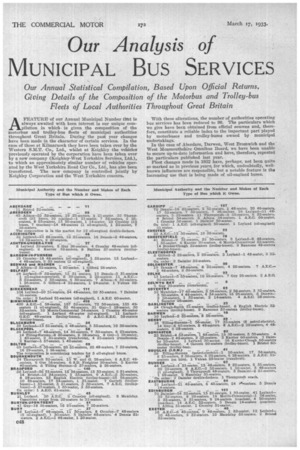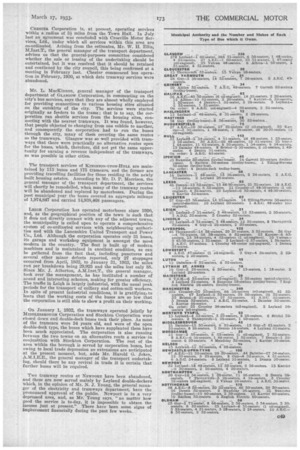Our Analysis of
Page 98

Page 99

Page 100

If you've noticed an error in this article please click here to report it so we can fix it.
MUNICIPAL Bus SERVICES
Our Annual Statistical Compilation, Based Upon Official Returns, Giving Details of the Composition of the Motorbus and Trolley-bus Fleets of Local Authorities Throughout Great Britain
AFEATURE of our Annual Municipal Number drat is always awaited with keen interest is our unique compilation in whichis given the composition of the pictorbus and trolley-bus fleets of municipal authorities throughout Great Britain. During the past year changes have been made in the character of certain services. In the case of those at Kilmarnock they have been taken over by the Western S.M.T. Co., Ltd., whilst at Keighley the vehicles previously operated by the corporation have been taken over by a new company (Keighley-West Yorkshire Services, Ltd.), to which an approximately similar number of vehicles operated by the West Yorkshire Road Car Co., Ltd., has also been transferred. The new company is controlled jointly by Keighley Corporation and the West Yorkshire concern. With these alterations, the number of authorities operating bus services has been reduced to 99. The particulars which we give have been obtained from official sources and, therefore, constitute a reliable index to the important part played by motorbuses and trolley-buses owned by municipal undertakings.
In the case of Aberdare, Darwen, West Bromwich and the West Monmouthshire Omnibus Board, we have been unable to secure up-to-date information and have, therefore, repeated the particulars published last year. Fleet changes made in 1932 have, perhaps, not been quite so marked as in previous years, for which, undoubtedly, wellknown influences are responsible, but a notable feature is the increasing use that is being made of oil-engined buses.
CHESTER Corporation is, at present, operating services Within a radius of 3i miles from the Town Hall. In July last an agreement was concluded with Crosville Motor Services, Ltd., under which all services within this area are co-ordinated. Arising from the estimates, Mr. W. H. Ellis, M.Inst.T., the general manager of the transport department, advises us that the general-purposes committee considered whether the sale or leasing of the undertaking should be entertained, but it was resolved that it should be retained and continued by the city council, this being confirmed at a meeting in February last. Chester commenced bus operation in February, 1930, at which date tramway services were abandoned.
Mr. L. MacKinnon, general manager of the transport department of GLASGOW Corporation, in commenting on the city's bus services, says that they are almost wholly employed for providing connections to various housing sites situated on the outskirts of the city. The services were started originally as feeders to the trams; that is to say, the corporation ran shuttle services from the housing sites, connecting with the nearest tramways. It was found, however, that people objected to changing from one vehicle to another, and consequently the corporation had to run the buses through the city, many of thena covering the same routes as the tramways. Glasgow was so well provided with tramways that there were practically no alternative routes open for the buses, which, therefore, did not get the same opportunity for earning a revenue independent of the tramways, as was possible in other cities.
The transport services of KrtiosToN-ineori-HuLL are maintained by 113 buses and 175 tramcars, and the former are Providing travelling facilities for those residing in the newly built housing estates. According to Mr. D. P. Morrison, the general manager of the transport department, the services will shortly be remodelled, when many of the tramway routes will be abandoned and replaced by motorbuses. During the past municipal year the buses covered an aggregate mileage of 1,974,847 and carried 14,938,468 passengers.
LEIGH Corporation has operated motorbuses since 1920, and, as the geographical position of the town is Such that it does not directly connect with any of the adjacent towns, the municipality is called upon to operate a comprehensive system of co-ordinated services with neighbouring authorities and with the Lancashire United Transport and Power 'Co., Ltd. Although the corporation operates only 31 buses, its garage and workshop equipment is amongst the most modern in the country. The fleet is built up of modern machines and is maintained in excellent condition, as can be gathered from the fact that, including punctures and several other minor defects reported, only 27 stoppages occurred from April, 1932, to January 31, 1933, the miles run per breakdown being 29,925 and the miles lost only 88. Since Mr. J. Atherton, A.M.Inst.T., the general manager, took over the management, he has instituted a number of sound and interesting schemes, making for greater efficiency. The traffic in Leigh is largely industrial, with the usual peak periods for the transport of colliery and cotton-mill workers. In spite of present industrial conditions, it is gratifying, to learn that the working costs of the buses are so low that the corporation is still able to show a profit on their working.
On January 1, 1932, the tramways operated jointly by MIDDLESBE017GH Corporation and Stockton Corporation Were closed down and double-deck buses took their place. As most of the tramcars were 34 years old, and were of the open double-deck type, the buses which have supplanted them have been much appreciated. The corporation is also running between the two towns on an alternative route a service-in conjunbtion with Stockton Corporation. The rest of the area within the borough is served by corporation buses, but owing to local trade depression no extensions are anticipated at the present moment, but, adds Mr. Harold G. Jeken, A.M.I.E.E., the general manager of the transport undertaking, should there be any revival in trade it is certain that further buses will be required.
Two tramway routes at NEwronr have been abandoned, and these are now served mainly by Leyland double-deckers which, in the opinion of Mr. N. J. Young, the general manager of the electricity and tramways department, have the pronounced approval of the public. Newport is in a very depressed area, and, as Mr. Young says, " no matter how good the service is to-day, it is impossible to obtain the income just at present." There have been some signs of improvement financially during the past few weeks. Mr. John F. Cameron, the enlrineer and general_manager of NONTRAMPTON Corporation's transport department, dues not contemplate any further purchases of buses this year, but makes it clear that any future purchases made will be in connection with the discarding of tramways. He stresses "a point that must be influencing many municipal authorities—i.e., that until something concrete arises from the Salter Report very little can be done.
The bus services of PORTSMOTITII Corporation, which cover 30 miles of route, operate in conjunction with, and supplemental to, the established tramway services, being extended through areas within the city boundary not served by the trams. Mr. Ben Hall, general manager and engineer of the undertaking, emphasizes the point that, as a medium of transport within the city, tho buses are considered as equally valuable and important as the trams. The corporation has displayed considerable enterprise in the operation of oilengined buses, and has over 20 such vehicles in its fleet. It is interesting to learn that the acquisition, at an early date, of a further 12 double-deck vehicles is being considered.
Mr. Benjamin 'England, A.M.Inst.T., A.M.I.A.E., advises us that ST. HELENS Corporation bus and trolley-bus services -are making excellent Progress. There are three trolley-bus , routes in operation, each of which has taken the place of an old tram route, whilst -a -fourth tram route is being temporarily operatedby motorbuses pending its -conversion to c50
trolley-bus working. There are four further tram services still running which, we learn, will in due course be converted to trolley-bus operation. The.policy of the .corporaton is to replace tramcars by trolley-buses, using petrol buses for routes which do not justify such a frequent service.
SOUTH SHIELDS Corporation is not operating any buses equipped with oil engines, and until that prime-mover has developed to a greater extent it is improbable, in the opinion of Mr. J. Austin Baker, M..I.Mech.E., M.I.A.E., that the transport committee will sanction a change-over. As the area of the borough is about .41 be extended, an application to operate two services to Marsden—a popular pleasure resort, just beyond the borough boundary—is now under consideration.
The tramcars and buses Owned by STALYERIDGE, HYDE, Mosnry and DIIKINEIELD Tramways and Electricity Beard provide a frequent service to adjacent towns ,and
Inter-running arrangements exiSt. With adjoining passengertransport authorities (Manchester, Oldham, Stockport and Ashton-under-Lyne, as well as the North Western Road Car Co., Ltd.), by means of which:many. services have been extended to link up outlying diStrioti:. "Under -norinsir eonditimes a heavy traflie of workpeople -is dealt with,.When-itte rolling stock is frequently taxedtothe limit,: says Mr. A. G. Grundy-, M.Inst.T., the transport-.manner.




































































































































































